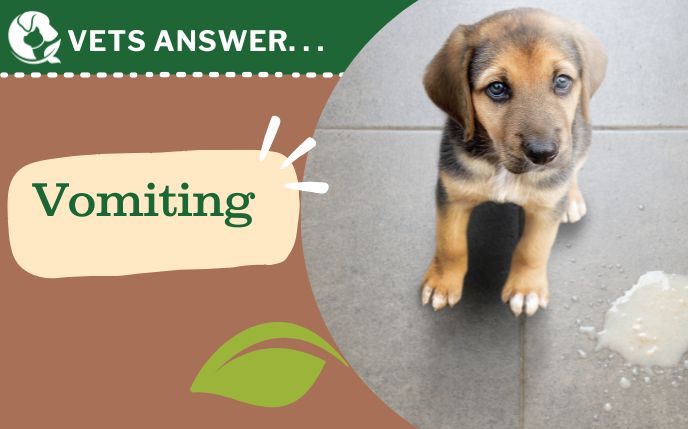What Throwing Up Can Mean for Your Pets
If you have a dog or cat who has a history of throwing up (vomiting), you may be worried. You want to stop the vomiting and help. This is natural and important.
You can help the most by learning more about the symptom of vomiting. Once you know more, you can use that information to make better decisions about what to do. Both quickly and through your companion animal’s life.
There is a difference between healing and just resolving the immediate problem. Healing both relieves symptoms and improves the patient’s life.
In all ways. Not only symptomatic relief.
For example, in our recent Lyme webinar, we discovered that Lyme is an over diagnosed and over treated disease. Overall healthy dogs exposed to Lyme don’t get sick. The strong immune system neutralizes any harmful effects from the Lyme bacteria. Anti-biotics may relieve the acute symptom, but they also can contribute to future problems.
In patients who throw up, using Prilosec or Pepcid to temporarily relieve symptoms is common practice. Proton pump inhibitors and H2 blocking anti-histamines may (or may not) relieve the symptoms. But your pets deserve longer term relief without the potential side-effects of medications. The holistic and homeopathic methods of understanding your pets are here to help. Their scientific framework can even help predict which patients may benefit from or suffer a side-effect from any medicine.
Any dis-ease symptom may resolve in the short term, but the quick fix doesn’t improve future health or dis-ease resistance.
Why is closely examining specific symptoms so important? Because understanding them is a way of learning more about the body and the healing process. The more we understand the signs and symptoms produced by the body, the more we understand how the body works.
Symptoms are a clue that there may be a deeper issue.
Let’s start our understanding of “vomiting” by differentiating it from regurgitation.
The Difference Between Vomiting and Regurgitation
Vomiting is active. It may appear as though the whole body is involved in the effort and you’ll see the stomach muscles contract. Often, they’ll vomit several times in a row.
Regurgitation is passive. It does not involve the forceful contraction of stomach muscles. Both vomiting and regurgitation can occur right after eating or drinking, or up to several hours later. In both cases the vomitus can look just like the food that was eaten.
If you don’t observe the act, then you can’t tell the difference. In order to fully describe vomiting, you have to observe it. Could there be an environmental modification or other holistic action that could stop the symptom (vomiting)? Perhaps you can just move a houseplant or switch food batches.
Other environmental and preventable causes include “garbage gut”, consumable toys (and toy parts-especially eyes and squeakers), strings, ribbon. garland, etc.
Another consideration is the frequency. Is the vomiting sporadic? Is it common (but not “normal”, even for cats)?
Your observed and described details along with your veterinarian’s physical exam findings, and diagnostic tests can determine the cause of the vomiting and predict effective holistic actions.
Common Causes for Throwing Up
1. Dietary “indiscretions” and overeating (as seen with “scarf and barfers”)
2. Toxicities and sensitivities (foods, plants, etc.)
3. Foreign Bodies
4. Drug induced (many)
5. Infectious and inflammatory
6. Motility dis-orders (like am bilious vomiting syndrome)
7. Hormonal (e.g. associated with heats)
8. Vomiting as one part of a group of “syndrome” symptoms (e.g. Cushing’s, hyperthyroidism, diabetes, etc.)
9. “Normal” vomiting? (common but not normal)
The best outcomes in dogs and cats that vomit can be seen when you look at the full picture of the individual. The holistic medical framework lets you do just that.
When Do You Take Your Pet for an Emergency Evaluation?
These are all times to take your pet into your vet or the emergency ER.
1. Persistent vomiting or retching
2. Moderate (like a tsp.) to large amounts (like a cup) of blood in vomit
3. Toxin exposure (and ingestion)
4. Breathing and choking problems (use your quick home exam)
5. Pain or isolating
6. Unproductive retching or bloating
7. Puppy or kitten repeated vomiting (was there a recent vaccination?)
8. Abnormal home exam (e.g., vitals, gum color and moistness, skin recoil, gum capillary refill)
When in doubt err on the side of caution.
What to do if you go to the ER?
1. The examination will help rule out an acute foreign body and any needed (indicated) lab work can quickly rule out dehydration from internal fluid shifts (as in HGE) and vomiting.
2. Supportive care with fluids, resting of the gastrointestinal system and observation.
3. You can spend (or save) a lot of money with emergency hospital diagnostic testing. Most of the time, quick screening tests (BUN, creatinine, red and white count etc.) are the only tests that are urgently needed. You can save hundreds of dollars by asking the ER doc if the tests can be done instead later by your family veterinarian.
The goal of your trip to the ER is to have a vet use their expertise to tell you if your pet has a life-threatening problem, and if so, starting to treat. Not to run expensive (and sometimes not indicated) tests “just in case”. Newly minted veterinarians may be prone to this and often staff animal ERs (I know, because I was one myself in 1985).
The more details you can share with the medical personnel, the faster the problem will be solved. Details like, how much and how often your pet vomits are critical. Knowing the contents of the vomitus is also very helpful. What’s in it?? Is there a “real” hairball, large amounts of blood (bright red, black, clots?) or foreign material. What is the consistency, color, does it have a strong odor? Are they any known triggers? How problematic and persistent is the vomiting? These factors help determine symptom context and significance.
Environmental sensitivities (modalities) are the best way to individualize your pet. This is how your companion animal’s body responds to various stimuli. Even though this information may not mean much to the ER vet, it is very important to know in order to resolve the internal cause for the vomiting.
Modification of symptoms by factors like when they happen, if they are better or worse inside or outside, response to environmental temperatures. Is there vomiting related to eating or drinking, pooping or peeing? Better alone or following you everywhere and wanting to be close are especially important in vomiting pets.
Other important clues include multiple symptoms happening at the same time (concomitants), like diarrhea + vomiting, etc.
It’s the ER vet’s goal just to rule out and treat emergencies. But as the full time guardian of your pet, you want to be sure you have all of the information you need to do the best.
It’s also important to know how and when to induce vomiting when it is associated with a foreign body or potentially toxic ingestion (like. In the case of a toxin, induce vomiting immediately using hydrogen peroxide. You can use a turkey baster to orally give as much as needed until vomiting starts. The peroxide bubbles up in the stomach to start the vomiting reflex and then it just becomes plain H2O (from H2O2).
Foreign body ingestion is another great time to induce vomiting. It’s better to prevent future potential obstructions than to have to treat them.
However, don’t induce vomiting when the ingested material can damage the throat when it comes back up. When there has been a caustic substance ingestion or eating of a sharp foreign body, it’s best not to induce vomiting.
After the emergency is over, review your pet’s lifestyle paying special attention to possible predisposing factors to the vomiting. Many vomiting causes can be found in the diet, activity level, environment and in over and unnecessary supplementation. Adjusting these periodically promotes healing in your pet’s body.
Prescription and over the counter medicines are also a big cause for vomiting. Avoid them when possible. Higher doses and longer duration of use can be especially problematic. Vomiting from arthritis medicines and other anti-inflammatories, anti-biotics, etc. is common. Sucralfate is one medicine prescribed commonly in vomiting pets that is usually safe to use (though not in pets with kidney dis-eases. It’s not absorbed well and works locally to coat and soothe vomiting-related problems.
Fasting is the single most effective but simple and safe Holistic Action that you can take. Resting the gut while it heals and regenerates works wonders.
Once the acute problem calms down, you can further support the body by feeding small bland meals, using liquid aloe vera, and supplements like Alicaid, Nutrigest, probiotics + probiotic multipliers, digestive enzymes, etc. It’s important for you to understand that supplements are supporting the natural healing process, but they’re not eliminating the underlying problem. Doing so may be enough to resolve acute vomiting, but not in chronic vomiting. To fully address the underlying chronic problem, you will need to understand the vomiting in context including your pet’s individuality.
Now What?
The current non-holistic advice is that there is no need for any action if the vomiting resolves. Some vomiting is “normal” after all. Especially if your dog or cat is eating (at all), and is bright and alert. Right?
However, by interpreting the (seemingly) isolated vomiting within the full context of your companion animal’s totality, you can make good use of this information. If you are working with a veterinary homeopath, we can use these early warning signals to prevent future severe vomiting episodes.
Here are some Holistic Actions that you can take. Today!
1. Define the problem- is it vomiting or regurgitation (or even a retching cough)?
2. Restrict Food and Water
3. Determine if ER needed for supportive care
4. Support with Fluids, aloe
5. Question use of steroids and anti-biotics (rarely indicated)
6. Observe and record in detail
7. Homeopathic treatment (modalities and concomitants key)
Even if you are not working with someone who can interpret common but abnormal vomiting (or other symptoms), you should at least record the symptoms for future reporting. A great place to do that is Dr. Christina Chambreau’s “Healthy Animal” journal.
Here’s where your observing and describing and recording come in handy. Start now and practice. Good observers are usually made, not born that way.
There are many ways to holistically resolve vomiting. Perhaps the most important take-away is for you to continue building up confidence in yourself. You are a critical part of your holistic vet care team. Embracing this fact will help you care for your pet when dealing with vomiting or other symptoms.
Educate yourself on the holistic medical scientific framework. Doing so will help you to solve both acute and recurring health challenges. Even better, knowing the significant factors will help you promote wellness and prevent dis-ease.
Be well.
Dr. Jeff

 In the mid-1990s, I was called out to see Justin, an Irish Wolfhound who was unable to get up.
In the mid-1990s, I was called out to see Justin, an Irish Wolfhound who was unable to get up.


